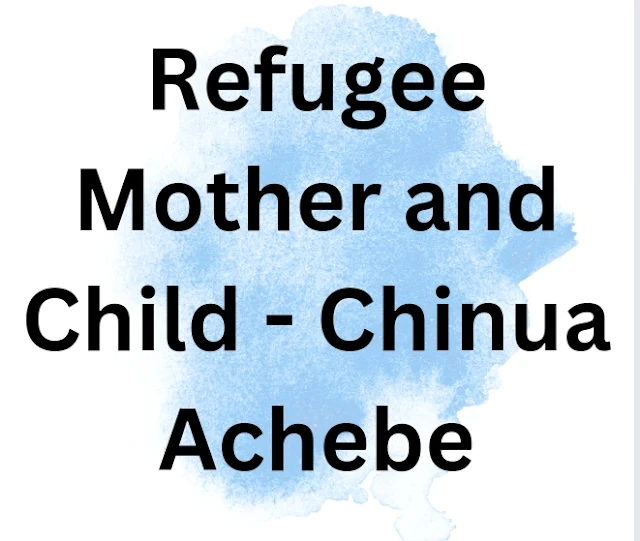Refugee Mother and Child - Chinua Achebe
Read More :-
- This is a Photograph of Me - Margaret Atwood
- Woman to Man - Judith Wright
- The Mystic Drum - Gabriel Okara
- I'm Getting Old Now - Robert Kroetsch
About Poet
Chinua Achebe (b. 1930), Nigerian novelist, short story writer and poet, worked as Professor of English at the University of Nigeria and as Director of two well-known publishing companies. As a prominent Ibo novelist, he was acclaimed for his unsentimental depictions of the social and psychological disorientation accompanying the imposition of Western customs and values on traditional African society. Things Fall Apart (1958), Achebe's first novel concerns traditional Ibo life at the time of the advent of the missionaries and of the colonial government in his homeland. In No Longer at Ease (1960) and Arrow of God (1964), Achebe renders the tones of Umnaro speech and thought and exhibits a concern for that rich native culture whose destruction is threatened by imported Western patterns of life. In A Man of the People (1966) he deals with corruption and the personality cult in a newly independent African state modelled on his own Nigeria. He published two volumes of his poetry: Beware, Soul- Brother (1971) and Christmas at Biafra (1973).
About Poetry
Chinua Achebe's 'Refugee Mother and Child' presents a realistic picture of a refugee mother and her child. The visual quality of the poem makes it all the more pathetic. Though the poet does not describe the location, the poem could take place anywhere in Africa where people are displaced, either because of a natural calamity like a famine or a political situation that has reduced people to the state of being refugees. The squalor and filth of the refugee camp is created with a minimum of words. But the emphasis is not on the background but on the picture of the mother and child. The emotional appeal becomes poignant when the poet compares the refugee mother to the Madonna, the picture of Virgin Mary that Christians hold dear. Through this comparison with the holy mother, the poet evokes a feeling that would salute all mothers. The poem touches deeper cords of the heart mainly through its simplicity and directness.
Refugee Mother and Child
No Madonna and Child could touch
that picture of a mother's tenderness
for a son she soon would have to forget
The air was heavy with odours
of diarrhoea of unwashed children
with washed-out ribs and dried-up
bottoms struggling in laboured
steps behind blown empty bellies. Most
mothers there had long ceased
to care but not this one; she held
a ghost smile between her teeth
and in her eyes the ghost of a mother's
pride as she combed the rust-coloured
hair left on his skull and then-
singing in her eyes-began carefully
to part it... In another life this
would have been a little daily
act of no consequence before his
breakfast and school; now she
did it like putting flowers
on a tiny grave.
Glossary
Line 1. Madonna the Virgin Mary, especially as seen in works of art; original Italian words mean 'my lady'
Line 1. Madonna and Child Mary and Jesus
Line 4. odours smells
Line 12. Ghost smile... ghost pride unseen smile... unseen pride
Explanatory Notes
Line 1-3. The poem is divided into two parts; that the first three lines make the first half is clear from the separation of the lines. Yet these lines have an obvious connection with the picture presented in the second half. This connection is suggested by not placing a full stop which makes a complete sentence after the first three lines.
Line 1. Madonna and Child: This reference to the Virgin Mary and her child Jesus Christ lifts the poem above the descriptive pathos of the second part. The Holy Mother's love for her child is justifiable and it shows her pride because she knows what her child is going to be: the Saviour of mankind. The world worships such motherhood because it is a source of salvation to all. 'Madonna' indicates that the poet is thinking more of the picture of the Mother and Child. Thus there are two pictures juxtaposed in the poem. This explains what the refugee mother must be feeling: the grief of the imminent loss of the child, the total negation of her life in losing what she has created. In this sense, no Madonna and child could ever touch (be worthy of comparison) the picture of the refugee and child. In this sense, this picture of the refugee mother is superior even to that of Mary. It is more pathetic than that of Mary because Jesus' crucifixion was at least valuable, it saved humanity This child is dying for no reason, and for nothing. Hence this grief is more tragic. This comparison saves the poem from becoming a mere graphic picture of grief.
Lines 4-21. The second part of the poem presents what could be called a 'conventional' picture of grief, usually found in any 'protest' literature (for example, Dalit Literature in Marathi). But the phrases 'odours of diarrhoea', 'dried-up bottoms' of children, 'empty bellies', 'washed-out ribs' produce only pathos, not anger. The total helplessness of the situation is beyond all repair. Nothing can be done to change this human plight. Though living, the mother has already become a ghost. Death, soon to come to the child and to the mother, has, in a way, become meaningless. The combing of the left-over rust-coloured hair of the child reminds one of Soyinka's lines, 'Rust is ripeness.' Therefore the poem aptly ends with a simile: her parting of the child's hair is like 'putting flowers on a tiny grave'. Death is pathetic, but the knowledge of dying is tragic. The poet seems to suggest that what the refugee mother has experienced perhaps never 'touched' even the greatest of our mothers: the Virgin Mary.
